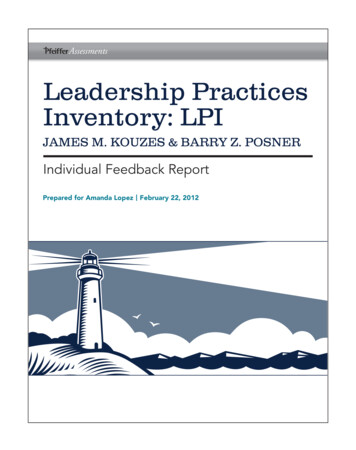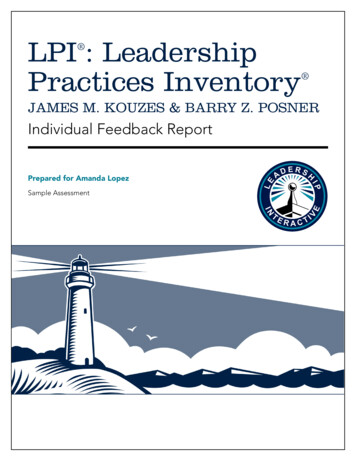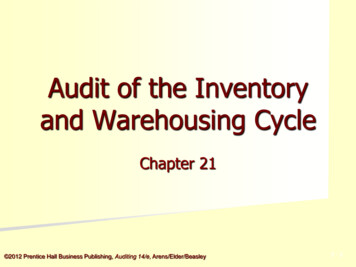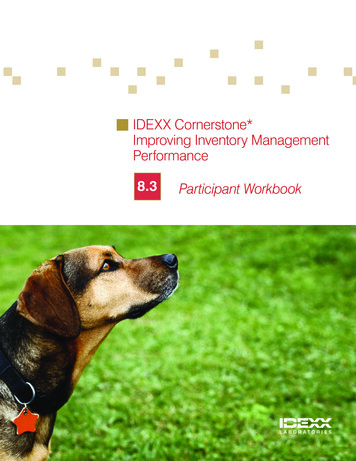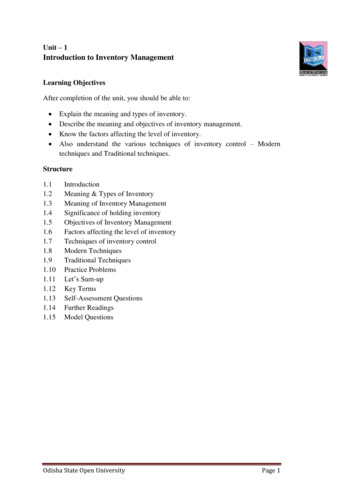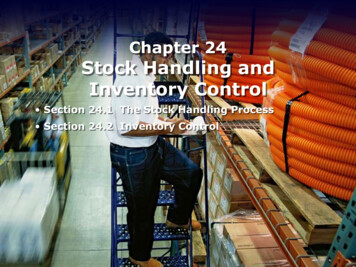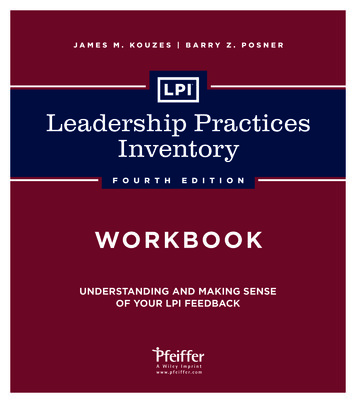
Transcription
james m. kouzes barry z. posnerLeadership PracticesInventoryF o u r t hE d i t i o nwo r k b o o kUnderstanding and Making Senseof Your LPI Feedback
Copyright 2013 by James M. Kouzes & Barry Z. Posner. All Rights Reserved.Published by PfeifferAn Imprint of WileyOne Montgomery Street, Suite 1200, San Francisco, CA 94104‑4594www.pfeiffer.comNo part of this publication may be reproduced, stored in a retrieval system, or transmitted in any formor by any means, electronic, mechanical, photocopying, recording, scanning, or otherwise, except aspermitted under Section 107 or 108 of the 1976 United States Copyright Act, without either the priorwritten permission of the Publisher, or authorization through payment of the appropriate per‑copy feeto the Copyright Clearance Center, Inc., 222 Rosewood Drive, Danvers, MA 01923, 978‑750‑8400, fax978‑646‑8600, or on the web at www.copyright.com. Requests to the Publisher for permission should beaddressed to the Permissions Department, John Wiley & Sons, Inc., 111 River Street, Hoboken, NJ 07030,201‑748‑6011, fax 201‑748‑6008, or online at http://www.wiley.com/go/permissions.Limit of Liability/Disclaimer of Warranty: While the publisher and author have used their best effortsin preparing this book, they make no representations or warranties with respect to the accuracyor completeness of the contents of this book and specifically disclaim any implied warranties ofmerchantability or fitness for a particular purpose. No warranty may be created or extended by salesrepresentatives or written sales materials. The advice and strategies contained herein may not besuitable for your situation. You should consult with a professional where appropriate. Neither thepublisher nor author shall be liable for any loss of profit or any other commercial damages, includingbut not limited to special, incidental, consequential, or other damages. Readers should be aware thatInternet websites offered as citations and/or sources for further information may have changed ordisappeared between the time this was written and when it is read.For additional copies/bulk purchases of this book in the U.S. please contact 800‑274‑4434.Pfeiffer books and products are available through most bookstores. To contact Pfeiffer directlycall our Customer Care Department within the U.S. at 800‑274‑4434, outside the U.S. at 317‑572‑3985,fax 317‑572‑4002, or visit www.pfeiffer.com.Pfeiffer publishes in a variety of print and electronic formats and by print‑on‑demand. Somematerial included with standard print versions of this book may not be included in e‑books or inprint‑on‑demand. If this book refers to media such as a CD or DVD that is not included in the versionyou purchased, you may download this material at http://booksupport.wiley.com. For more informationabout Wiley products, visit www.wiley.com.ISBN: 978‑1‑118‑18273‑4Acquiring Editor: Marisa KelleyEditor: Rebecca TaffDirector of Development: Kathleen Dolan DaviesManufacturing Supervisor: Becky MorganDevelopment Editor: Janis ChanDesigner: izles designProduction Editor: Dawn KilgorePrinted in the United States of AmericaPrinting10987654321
CONTENTSWelcomepage 1Make the Most of Your LPI Feedbackpage 1Why You Can Trust the Feedbackpage 2Leadership Behaviors Organized by Practicepage 3The Ten Commitmentspage 5First Impressionspage 7Exploring Consistencypage 10Patterns and Messagespage 13Focus Your Developmental Effortspage 20Sample Leadership Development Worksheetpage 24Leadership Development Worksheetpage 26Go Public with Your Planpage 29Discussing Your Feedback withYour Observerspage 31Available Resourcespage 33Further Readingpage 35About the Authorspage 41
WelcomeMake the Most of Your LPI FeedbackThis probably doesn’t come as any surprise to you, but there’sno such thing as instant leadership—or instant expertise of anykind. Those who are the very best at anything became that waybecause they had a strong desire to excel, a belief that new skillsand abilities can be learned, and a willing devotion to deliberatepractice and continuous learning. What truly differentiates theexpert performers from the good performers is hours of practice.Deliberate practice. The best leaders work at becoming the best,and it doesn’t happen over a weekend.Here are some tips on how you can get the most learning out of the LPI process. Accept the feedback as a gift. Feedback may not come wrapped in a package1I increase the frequency of the behaviors measured by the LPI?” It will. Researchconsistently shows the same results: The more frequently you demonstratethe behaviors included in the LPI, the more likely you will be seen as aneffective leader.pag e Take the feedback seriously. You might wonder, “Will it really make a difference if with a bow, but it’s still one of the most valuable gifts you’ll ever receive. Why?Because we know from our research that leaders who are the most open tofeedback are far more effective than leaders who resist hearing other people’sperspectives on their behaviors.l p i wo r k b o o kThose who are the best at leading are also the best at learning. Exemplary leadersdon’t rest on their laurels or rely on their natural talents; instead, they continually domore to improve themselves. So if you want to be the best you can be, you need tobecome a great learner.
Value the differences in your observers’ perspectives. You’re a multi‑dimensionalperson, and your feedback ought to be multi‑dimensional as well. You workwith people from a variety of backgrounds and from a variety of functions andorganizations. Feedback from these multiple perspectives helps you see how youlead across groups and situations. The feedback from each observer helps youbuild a more complete picture of how effective you are as a leader. Plan now to retake the LPI. Great leaders continually set goals and seekfeedback. The LPI gives you a snapshot in time. It is a beginning point fromwhich to move forward. To heighten your focus and practice with great purpose,decide now that you will retake the instrument within a specific period of time—we recommend between six and nine months—to see how you are doing andidentify new priorities for your practice.Why You Can Trust the Feedbackl p i wo r k b o o kWhen we developed the LPI, we conducted several tests to ensure that the instrumenthad sound psychometric properties. Our own, as well as independent studies,consistently confirm that the LPI has very strong reliability and validity. Reliabilitymeans that the six statements pertaining to each leadership practice are highlycorrelated with one another.Test/re‑test reliability is also high. This means that scores from one administrationof the LPI to another within a short time span (a few days or even months) andwithout any significant intervening event (such as a leadership training program) areconsistent and stable. pag eThe LPI has both face validity and predictive validity. “Face validity” means thatthe results make sense to people. “Predictive validity” means that the results aresignificantly correlated with various performance measures and can be used to makepredictions about leadership effectiveness.2
Leadership Behaviors Organized by PracticeModel the Way1.6.Sets a personal example of what he/she expects of others.11.16.Follows through on promises and commitments he/she makes.21.Builds consensus around a common set of values for runningour organization.26.Is clear about his/her philosophy of leadership.Spends time and energy making certain that the people he/she works with adhere to the principles and standards we haveagreed on.Asks for feedback on how his/her actions affect otherpeople’s performance.Inspire a Shared VisionTalks about future trends that will influence how our workgets done.7.12.17.Describes a compelling image of what our future could be like.22.27.Paints the “big picture” of what we aspire to accomplish.Appeals to others to share an exciting dream of the future.Shows others how their long-term interests can be realized byenlisting in a common vision.Speaks with genuine conviction about the higher meaning andpurpose of our work.8.Challenges people to try out new and innovative ways to dotheir work.13.Searches outside the formal boundaries of his/her organization forinnovative ways to improve what we do.3Seeks out challenging opportunities that test his/her own skillsand abilities.pag e3. Challenge the Processl p i wo r k b o o k2.
18.23.Asks “What can we learn?” when things don’t go as expected.28.Experiments and takes risks, even when there is a chance of failure.Makes certain that we set achievable goals, make concrete plans,and establish measurable milestones for the projects and programsthat we work on.Enable Others to Act4.Develops cooperative relationships among the people he/sheworks with.9. Actively listens to diverse points of view.14. Treats others with dignity and respect.19. Supports the decisions that people make on their own.24. Gives people a great deal of freedom and choice in deciding how todo their work.29.Ensures that people grow in their jobs by learning new skills anddeveloping themselves.l p i wo r k b o o kEncourage the Heart5.10.Praises people for a job well done.15.Makes sure that people are creatively rewarded for theircontributions to the success of projects.20.Publicly recognizes people who exemplify commitment toshared values.Makes it a point to let people know about his/her confidence intheir abilities. 25. Finds ways to celebrate accomplishments.30. Give the members of the team lots of appreciation and support forpag etheir contributions.4
The Ten Commitments OF EXEMPLARY LEADERSHIPModel the Way Clarify values by finding your voice and affirming shared values. Set the example by aligning actions with shared values.Inspire a Shared Vision Envision the future by imagining exciting and ennobling possibilities. Enlist others in a common vision by appealing to shared aspirations.Challenge the Process Search for opportunities by seizing the initiative and by looking outward forinnovative ways to improve. Experiment and take risks by constantly generating small wins and learningEnable Others to Act Foster collaboration by building trust and facilitating relationships. Strengthen others by increasing self‑determination and developing competence. Celebrate the values and victories by creating a spirit of community.pag e Recognize contributions by showing appreciation for individual excellence. Encourage the Heartl p i wo r k b o o kfrom experience.5
Notesl p i wo r k b o o k pag e6
First ImpressionsTo keep in mind when reviewing your LPI report: There is no such thing as a “bad” score, or even a “good” score. The LPI scoresare a snapshot—an objective, current view of your leadership behaviors. They arenot “grades” but opportunities for you to become more comfortable and skillfulas a leader. Look for messages in the data, not scores. You may be receiving feedbackfrom your manager, your direct reports, your peers, and others with whom youinteract. It’s easy to get lost in all the numbers. But don’t let the data overwhelmyou. Ask yourself, “What are people trying to tell me about my leadershipbehaviors?” “What am I doing or not doing that is causing people to rate me theway they do?” “Where do I see consistencies and inconsistencies?” “Where arethere patterns that shape how others see my leadership?” Treat the LPI feedbacknot as a report card, but as valid and useful information that you can use tobecome a better leader.observers’ ratings. Remember that the purpose of this assessment is to identifywhat you can do to become a better leader. Remember that the observers are referred to by letters and numbers instead ofby name so they remain anonymous. Do not waste your time attempting to figureout who D1 or C3 might be. It does not matter, and you are likely to be incorrectanyway. Instead, concentrate on the messages.l p i wo r k b o o k Take personal ownership of the scores instead of thinking up excuses for your Do not be surprised if one observer rates you significantly lower in most if notpag e7all of the practices. You do not interact with everyone equally; the lower ratingusually indicates that that observer does not see you engaging in the practicebehaviors very frequently. You might have to think about and create new ways toensure your leadership is more visible.
Check any of the words in the list below that express what you felt when youfirst looked at your LPI feedback. Use the space below the list to write any otherfeelings you had. Amused Relieved Disappointed Humbled Embarrassed Other: Pleased Confused Upset Anxious Neutral—no strong feelingsL P I WO R K B O O K1. What was your strongest feeling? Challenged Surprised Angry Concerned PAg E8
2. Why does this feedback make you feel that way?3. Please describe anything in your Feedback Report that is confusing,incomplete, or contradictory.L P I WO R K B O O K PAg E9
Exploring ConsistencyConsistency in behavior is important to your credibility. It letsothers know that they can count on you to be consistent in youractions so they know what to expect from you.In the ideal scenario, your Self ratings would be very consistent with your Observerratings. But in the real world, scores are not always consistent.There are a number of valid explanations for inconsistency in your feedback. Forinstance, some people know you better, people in various roles (or varying functions)have differing expectations of you, and you may behave differently with some peoplethan with others. What’s important is to understand why people rate you differentlythan you rate yourself and think about the extent to which you need to be consistent.L P I WO R K B O O KLook through your feedback report quickly, paying special attention to thedata summary pages for each of the Five practices. think about the questionson the facing page. if you wish, there is space on the following page to recordyour thoughts. PAg E10
Compare your Self ratings to your Observer ratings How consistent are your Self ratings with those of your Observers? In otherwords, do you rate yourself higher than, lower than, or about the same asothers rate you? Where are the Self and Observer ratings the most consistent?Compare the observers’ ratings with one another How consistent are your Observer ratings with one another? Do they tend to seeyour behavior in similar ways or not? Where are the Observer ratings the most consistent with one another?Think about possible reasons for inconsistencies Where are your Self ratings the most inconsistent with your Observer ratings? Where are your Observer ratings most inconsistent with one another?Look for any “outliers”—observers whose scores seemparticularly high or particularly low Do any of your Observers’ ratings seem extremely inconsistent with thoseof the others? Why do you think that is so? Does it have to do with the situation? Thelpi workbook What might be some reasons for the inconsistencies?relationship? You? Some other factors?11 pag e What can you learn from these outliers?
Noteslpi workbook pag e12
Patterns and MessagesAny data, whether from the LPI or from another source, is onlynumbers or words until you can make sense of it. When you lookat an impressionist painting from a few inches away, for instance,it’s not much more than colored dots; it’s only when you standback that a pattern appears. In the same way, stand back fromyour data and see what emerges. What patterns do you see? Whatmessages does the data give you?Look at the Leadership Behaviors Ranking Page1.What three to five behaviors received the highest ratings from yourobservers? On your report, put a plus sign ( ) next to those items. Those are theitems that your observers agree you do most frequently. Copy them below.observers? Put a minus sign (–) next to those items. Those are the items that your observers agree that you do least frequently—behaviors in which you might need themost improvement. Copy them below.lpi workbook2. What three to five behaviors received the lowest ratings from yourpag e13
3. What do these ratings tell about where you are most comfortable andwhere you might need to improve?Look at the top ten behaviors on this page (the ones your observers think you engagein the most frequently) and the bottom ten behaviors (those your observers think youengage in the least frequently).4. What patterns do you see among the ten most frequent behaviors?lpi workbook5. What patterns do you see among the ten least frequent behaviors?6. What do those patterns tell you? pag e14
Noteslpi workbook pag e15
Turn to the Percentile Ranking PageThe Percentile Ranking page of your LPI Feedback Report shows how your Self andObserver scores compare with a large sample of Observer ratings for leaders who havealso taken the LPI.Fill out the chart below by placing a check mark in the appropriate spaces for correspondingrater type, response, and percentile ranking. Then answer the questions on the next page.Percentilebelow 30thSelfManagerDirect ReportCo-WorkerOtherlpi workbook30th-70thSelfManagerDirect ReportCo-WorkerOther70th-100th Selfpag eManager16Co-WorkerDirect ReportOtherModeltheWayInspirea SharedVisionChallengetheProcessEnableOthersto ActEncouragetheHeart
1. Where do your scores fall in relationship to other leaders inthe LPI database?2. Does the completed chart on the previous page tell you anything newabout the consistency or lack of consistency between your scores? If so,what does the chart clearly show that wasn’t so noticeable on the previous pages? pag e17%lpi workbook3.What does this page tell you about where you are most comfortable asa leader and where you need to improve?
Consider Additional FeedbackYou may have received feedback on your leadership behavior from the essay sectionof the LPI report and from other sources, such as surveys, oral or written assessmentsfrom your manager, and interactions with others.1. How does the LPI feedback compare to other feedback you’ve received?Where are the messages consistent, and where are there differences?2. What might be the reasons for the differences?lpi workbook3. What additional information would you like to have? Howcould you get it? pag e18
Noteslpi workbook pag e19
Focus Your Developmental EffortsIf you want to be a leader, you have to pay attention to thoseleadership behaviors that seem most comfortable for you andthose you don’t engage in as frequently.Take it one step at a time. Small wins create momentumfor change.According to researchers, what truly differentiates the great from the merely goodor average, regardless of their fields, is hours and hours of practice in order to obtainmastery in their fields and endeavors.It is only through deliberate practice—focused, planned learning activities designedto improve a specific aspect of performance and usually guided by a trainer orcoach—that you can develop your leadership capacity. That is true whether youwant to improve your strengths—the skills you already have—or strengthen yourweak behaviors.lpi workbook pag e20
To use your LPI feedback to improve, follow these steps:1. Use your LPI feedback to identify your priorities for improvement and setspecific goals.2. Make a plan to achieve your goals.3. Go public with your plan.4. Obtain feedback and support.Identify your prioritiesTake another look at the Leadership Behaviors Ranking page in your LPI FeedbackReport. Where would you like to focus your developmental efforts?1. Behaviors to keep practicinglpi workbook2. Behaviors to strengthen pag e21Circle one behavior to maintain at current rate of frequency and one behavior topractice more frequently as your top priorities at this time. Then complete theLeadership Development Worksheet on pages 26 and 27 to set your goals for thenext learning project and come up with a plan for achieving them. (There is a sampleworksheet on pages 24 and 25.)
When you achieve your goals, you can choose two more prioritiesand repeat the process. You can download blank worksheets atwww.leadershipchallenge.com/go/lpiworksheet.In addition to practice, you need good coaching, andThe Five Practices of Exemplary Leadership provides acoaching framework. But remember that improvementbegins by first acknowledging that you can be a betterleader than you are today and that you want to put forththe effort to achieve that. No amount of coaching orpractice can force you to improve. The motivation comesfrom within. But here’s something we know from ourresearch: The best leaders are the best learners.lpi workbookThose who perform at the highest levels believethat, no matter how good they are, they canalways be better. Less is not more when it comes tolearning. More is more. pag e22
Noteslpi workbook pag e23
Leadership Development Worksheettoday’s date: May 1, 2013Leadership Development Period: May 2 – 22, 2013 My two top priorities for this period: Write a compelling vision statement andpresent it to my team A LEADERSHIP BEHAVIOR to keep practicing: Model the Way: Continue asking forfeedback from team members on how my actions affect their performance A LEADERSHIP BEHAVIOR to strengthen: Inspire a Shared vision: Describe alpi workbookcompelling image of the future and enlist team members in that common visionMy goals (what I want to achieve): Write and present a compelling vision of the futurethat my team shares pag eThe benefits of achieving these goals: We will be energized and enthusiastic aboutworking together toward our common goal; we will be more productive; we will be better ableto achieve our team’s mission.24SAMPLE
My measure of success (how I will know when I have reached my goals):Team members give me feedback that lets me know they understand and share my visionActions I will take to achieve my goals Action: Write a 5 to 7 minute vision statement Date by which I will take this action: May 8 Action: Ask for feedback on my draft vision statement from Luis, who does this betterthan anyone I know, revise it, ask him to review the revised draft, and make any additionalchanges that might be needed Action: Present my vision statement to my team, ask for their feedback, revise it again,and present the revised statement to the team Date by which I will take this action: May 22pag e25SAMPLEPeople who will provide support: My manager, Teri, and my team members People who will give me feedback: Luis and my team membersl p i wo r k b o o k Date by which I will take this action: May 15
Leadership Development Worksheettoday’s date:Leadership Development Period: My two top priorities for this period: A LEADERSHIP BEHAVIOR to keep practicing: A LEADERSHIP BEHAVIOR to strengthen:lpi workbookMy goals (what I want to achieve): pag eThe benefits of achieving these goals:26
My measure of success (how I will know when I have reached my goals):Actions I will take to achieve my goals Action: Date by which I will take this action: Action: Action: Date by which I will take this action:pag ePeople who will provide support: People who will give me feedback:lpi workbook Date by which I will take this action:27
notesL P I WO R K B O O K PAg E28
Go Public with Your PlanResearch has shown that people are more likely to honor theircommitments when they share them with others.1. Share your Leadership Development Plan with a colleague.Summarize the following: The two top priorities that emerged from your LPI feedback and your reasons forchoosing them Your goals, the benefits of achieving those goals, the actions you will take forachieving goals, and your timetable toward your goalsl p i wo r k b o o k The people who will provide feedback and support as you workpag e29
2. In talking over your Leadership Development Plan with a colleague,summarize his or her feedback.3. What changes, if any, will you make to your plan, based on yourcolleague’s feedback?l p i wo r k b o o k pag e30
Discussing Your Feedbackwith Your ObserversWhen people offer feedback, they’d like to know that you valuethis gift and that you intend to do something with it. Plan aconversation (or conversations) with your observers in which to dothe following: Thank your observers for their feedback. Acknowledge what messages you heard and ask for any necessary clarification. Tell observers what you are going to do and the benefits you expect. Ask for their continuing feedback and support.It’s up to you whether to meet with observers as a group or one‑on‑one. Here aresome suggestions for holding productive conversations:the observers. Be honest about the feedback you received and how you felt about it. Byexpressing your feelings, you will more easily establish trust. Whether you share the actual scores or just highlight the highs, lows, and need Remember to let your observers know that you welcome their feedback and31appreciate their support.pag e Listen carefully and with an open mind to what your observers have to say. more clarity areas is up to you. But be sure to protect your observers’ anonymityby not asking them to disclose the scores they gave you.l p i wo r k b o o k Think ahead of time about what you want to say and what you would like from
Notesl p i wo r k b o o k pag e32
Available ResourcesWe hope you have found your experience with the LeadershipPractices Inventory (LPI) assessment insightful and worthwhile.If you are looking for everyday opportunities to make a smalldifference in your world, need tools to start or a communityto keep inspired, obtain feedback on how you are doing, orimplement a leadership development program within yourorganization, we can help. Here are some of the resources you candraw on as you begin or continue your leadership journey.BooksJim and Barry’s books include The Leadership Challenge, Credibility, Encouragingthe Heart, The Truth About Leadership, A Leader’s Legacy, The Student LeadershipChallenge, and The Academic Administrator’s Guide to Exemplary Leadership. pag eJim and Barry believe that an important part of the learning process is practice,practice, practice, so they have created The Leadership Challenge Workbook, TheEncouraging the Heart Workbook, Strengthening Credibility: A Leader’s Workbook, TheLeadership Challenge Practice Book, and The Leadership Challenge Vision Book. Theseinteractive tools are designed to be used on that proverbial Monday morning whenyou are faced with a problem or situation and would like to resolve the issue usingtheir framework.lpi workbookWorkbooks33
AppThe Leadership Challenge Mobile Leader Tool, a smart phone application, is aconvenient way to examine and employ The Five Practices of Exemplary Leadership and the thirty LPI behaviors in your daily life. Features of the app include a seamlessrequest-and-receive feedback process through which overall leadership performancecan be tracked and measured, helpful action planning routines, model overview, and aninspirational quote of the day.VideosThese visual aids to The Leadership Challenge program bring inspiring, real‑lifeexamples to the leadership development process. There are multiple video caseexamples of each of The Five Practices of Exemplary Leadership.Workshoplpi workbookThe Leadership Challenge Workshop is a unique, intensive program that consistentlyreceives rave reviews from attendees. It has served as a catalyst for profoundleadership transformation in organizations of all sizes and in all industries. The programis highly interactive and stimulating. Participants experience and apply Jim and Barry’sleadership model through video cases, workbook activities, group problem‑solvingtasks, lectures, and outdoor action learning. Quite often we hear workshop attendeesdescribe how The Leadership Challenge is more than a training event and talk abouthow it changed their lives. It’s a bold statement, we know, but we’ve watched it happentime after time, leader after leader. pag eCombined, these resources truly make Jim and Barry the most trusted sourcesfor becoming a better leader. To find out more about these products, please visitwww.leadershipchallenge.com. If you would like to speak to a leadership consultantabout bringing The Leadership Challenge to your organization or team, call866‑888‑5159 (toll free).34
Further ReadingGeneral LeadershipBurlingham, B. Small Giants: Companies That Choose to Be Great Instead of Big.New York: Penguin Group, 2005.Collins, J. Good to Great: Why Some Companies Make the Leap and Others Don’t.New York: HarperCollins, 2001.Collins, J. Great by Choice: Uncertainty, Chaos, and Luck: Why Some Companies ThriveDespite Them All. New York: HarperCollins, 2011.Gallos, J. V. (Ed.). Business Leadership: A Jossey‑Bass Reader. San Francisco:Jossey‑Bass, 2003.Hamel, G. What Matters Now: How to Win in a World of Relentless Change, FerociousCompetition, and Unstoppable Innovation. San Francisco: Jossey‑Bass, 2012.Hamm, J. Unusually Excellent: The Necessary Nine Skills Required for the Practice ofGreat Leadership. San Francisco: Jossey‑Bass, 2011.Peters, T. Re‑Imagine! Business Excellence in a Disruptive Age. New York:DK Publishing, Inc., 2003.lpi workbookPfeffer, J. What Were They Thinking?: Unconventional Wisdom About Management.Boston: Harvard Business School Press, 2007. Heifitz, R. A., and Linsky, M. Leadership on the Line: Staying Alive Through the Dangersof Leading. Boston: Harvard Business School Press, 2002.Kawaski, G. Enchantment: The Art of Changing Hearts, Minds, and Actions. New York:Portfolio, 2011.Kouzes, J. M., and Posner, B. Z. The Truth About Leadership: The No‑Fads,Heart‑of‑the‑Matter Facts You Need to Know. San Francisco: Jossey‑Bass, 2010.35Thompson, R. H. The Offsite: A Leadership Challenge Fable. San Francisco:Jossey‑Bass, 2008pag ePorras, J., Emery, S., and Thompson
May 01, 2013 · james m. kouzes barry z. posner Fourth edition Leadership Practices Inventory Understanding and Making sense . Leadership Behaviors Organized by Practice Page 3 The Ten Commitments Page 5 . Challenge the process 3. Seeks out challenging


